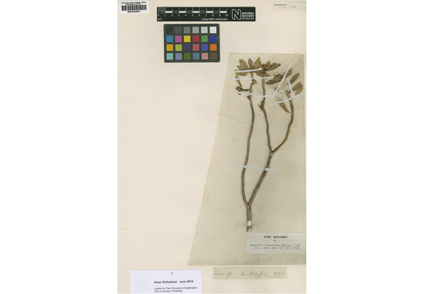Abstract
N/A
References
- Aiton, W. (1789) Hortus kewensis, or, a catalogue of the plants cultivated in the Royal Botanic Garden at Kew 2. George Nicol, London, 460 pp. https://doi.org/10.5962/bhl.title.116053
- Bally, P.R.O. (1965) Miscellaneous notes on the flora of Tropical East Africa, including descriptions of new taxa. Candollea 20: 13–41.
- Børgesen, F. (1924) Contributions to the knowledge of the vegetation of the Canary Islands (Teneriffe and Gran Canaria). Kongelige Danske Videnskabernes Selskabs Skrifter, Naturvidenskabelige og Mathematisk Afdeling 8 (6.3): 283–399.
- Bridson, G.D.R., Phillips, V.C. & Harvey, A.P. (1980) Natural History manuscript resources in the British Isles. Mansell, London and R.R. Bowker Company, New York, 473 pp.
- Britten, J. (1912) The history of Aiton’s “Hortus Kewensis”. Journal of Botany 50 (Suppl. 3): 1–16.
- Brown, N.E., Hutchinson, J. & Prain, D. (1911) Euphorbiaceae. In: Oliver, D. (Ed.) Flora of tropical Africa 6 (1.3). L. Reeve and Co., London, pp. 441−576.
- Deflers, M.A. (1887) Nouvelles contributions a la flore d’Aden. Bulletin de la Société Botanique de France 34: 61–69. https://doi.org/10.1080/00378941.1887.10830202
- Fennane, M. (2007) Euphorbiaceae. In: Fennane, M., Ibn Tattou, M., Mathez, J., Ouyahya, A. & El Oualidi, J. (Eds.) Flore pratique du Maroc, vol. 2. Institut Scientifique Service des Publications, Université Mohammed V, Agdal, Rabat, pp. 208−233.
- Krok, T.O.B.N. (1925) Bibliotheca botanica suecana. Almqvist & Wiksell, Uppsala & Stockholm, 799 pp.
- Maire, R.C.J.E. (1938) Contributions à l’étude de la flore de l’Afrique du Nord 26. Bulletin de la Société d’histoire Naturelle de l’Afrique du Nord 29: 1–543.
- Marrero Gómez, M.C., Rodríguez, O. & Wildpret de la Torre, W. (1999) Contribución al estudio taxonómico y descriptivo de la tabaiba dulce (Euphorbia balsamifera). Revista de la Academia Canaria de Ciencias 10: 265–286.
- Marrero Gómez, M.C., Rodríguez, O. & Wildpret de la Torre, W. (2000) Contribución al estudio etnobotánico de la tabaiba dulce (Euphorbia balsamifera). Anuario de Estudios Atlanticos 46: 19–76.
- Masson, F. (1796) Stapeliæ novæ: or, a collection of several new species of that genus; discovered in the interior parts of Africa. Printed by W. Bulmer and Co. for George Nicol, London, 24 pp. + 41 plates. https://doi.org/10.5962/bhl.title.102996
- Molero, J., Garnatje, T., Rovira, A. & Susanna, A. (2002) Karyological evolution and molecular phylogeny in Macaronesian dendroid spurges (Euphorbia subsect. pachycladae). Plant Systematics and Evolution 231: 109–132. https://doi.org/10.1007/s006060200014
- Molero, J., Riina, R. & Morawetz, J. (2011) Euphorbia balsamifera Ait. In: Euphorbia Planetary Biodiversity Inventory. Available from Tolkin: https://app.tolkin.org/projects/72/taxa/93065? (accessed: 13 December 2023).
- Peirson, J.A., Bruyns, P.V., Riina, R., Morawetz, J.J. & Berry, P.E. (2013) A molecular phylogeny and classification of the largely succulent and mainly African Euphorbia subg. Athymalus (Euphorbiaceae). Taxon 62: 1178–1199. https://doi.org/10.12705/626.12
- Rauschenberg, R.A. (1968) Daniel Carl Solander, naturalist on the “Endeavour”. Transactions of the American Philosophical Society 58: 1–66. https://doi.org/10.2307/1006027
- Reichenbach, H.G.L. (1829 [‘1828’]) Conspectus regni vegetabilis. Carolus Cnobloch, Leipzig, 294 pp.
- Riina, R. (2020) Three sweet tabaibas instead of one: splitting former Euphorbia balsamifera s.l. and resurrecting the forgotten Euphorbia sepium. Euphorbia World 16: 41–45.
- Riina, R., Villaverde, T., Rincón-Barrado, M., Molero, J. & Sanmartín, I. (2021) More than one sweet tabaiba: Disentangling the systematics of the succulent dendroid shrub Euphorbia balsamifera. Journal Systematics and Evolution 59: 490–503. https://doi.org/10.1111/jse.12656
- Rodríguez Delgado, O. & Beltrán Tejera, E. (1990) Contribución al conocimiento de los tabaibales dulces de las Islas Canarias. Catálogo florístico del subpiso basal de Euphorbia balsamifera Ait. en la Comarca de Agache (Güímar, Tenerife). In: Alonso Quecuty, R.M. et al. (Eds.) Homenaje al profesor Dr. Telesforo Bravo 1. Secretariado de Publicaciones, Universidad de La Laguna, La Laguna, pp. 595–642.
- Stafleu, F.A. & Cowan, R.S. (1976) Taxonomic literature. Ed. 2, 1. Bohn, Scheltema & Holkema, Utrecht, 1136 pp.
- Stafleu, F.A. & Cowan, R.S. (1981) Taxonomic literature. Ed. 2, 3. Bohn, Scheltema & Holkema, Utrecht, 980 pp.
- Stafleu, F.A. & Cowan, R.S. (1985) Taxonomic literature. Ed. 2, 5. Bohn, Scheltema & Holkema, Utrecht, 1066 pp.
- Thiers, B. (2023 onwards) Index Herbariorum: A global directory of public herbaria and associated staff. New York Botanical Garden’s Virtual Herbarium. Available from: http://sweetgum.nybg.org/ih/ (accessed: 15 July 2023).
- Turland, N.J., Wiersema, J.H., Barrie, F.R., Greuter, W., Hawksworth, D.L., Herendeen, P.S., Knapp, S., Kusber, W.-H., Li, D.-Z., Marhold, K., May, T.W., McNeill, J., Monro, A.M., Prado, J., Price, M.J. & Smith, G.F. (Eds.) (2018) International Code of Nomenclature for algae, fungi, and plants (Shenzhen Code) adopted by the Nineteenth International Botanical Congress Shenzhen, China, July 2017. Koeltz Scientific Books, Königstein, 254 pp. https://doi.org/10.12705/Code.2018
- Walker, C.C. & Thorburn, M. (1987) The euphorbias of Gran Canaria, Canary Islands. Euphorbia Journal 4: 33–47.
- Webb, P.B. & Berthelot, S. (1846–1847) Histoire Naturelle des Îles Canaries 3, sect. 3. Béthune, Paris, pp. 253–254.


